Do you mark time, pass time, waste time or keep time? Do you never have enough of it, try to spend it, save it or find it flying by? Is time on your side or running against you? From the speeded-up seconds when you’re rushing late to an appointment, to the glacial ticking of the clock when you’re waiting for something (or someone) desperately wished for, time is a strange thing. For the amount of time we spend ruminating on it, we are all held in its relentless grip – although, as philosophers, scientists and Zen masters could tell you, it is actually just a construct. Neuropsychologists and social anthropologists may add that our conception of time is a function of how our brains perceive experience and of our particular society’s desire to control that experience. All time is not created equal.
It was a clock that first inspired Dawn Williams of the Crawford Art Gallery, in Cork, to put together an exhibition exploring the meanings of time. “You know those artworks that you come across once in a while and they just stop you in your tracks?” says the curator, who saw Gail Ritchie’s Time: A Structure of Nothingness online during the Covid pandemic. Words wrap around Ritchie’s clock in place of numbers: forget, remember, hold on, blame, let go ... “It’s like the stages of grief,” Williams says.
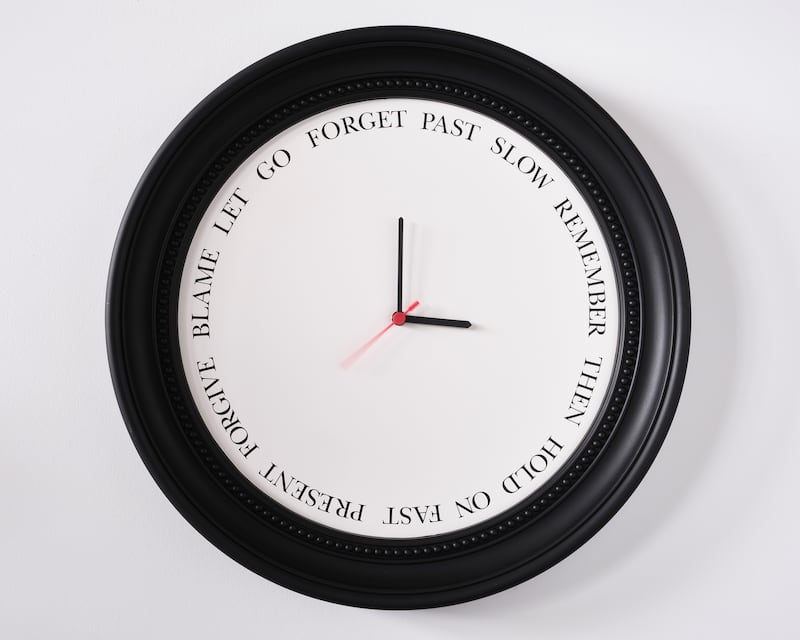
The exhibition, which is called A Matter of Time, begins with love and ends in the Crawford’s upstairs gallery with epic myth and war – but that is to oversimplify the powerful and subtly selected works on show.
It opens gently, with Kathy Prendergast’s The End and The Beginning II: three old-fashioned cotton reels, which are wound with the intertwined hair of three generations. Another Ritchie work, Cloakroom Study: From the Museum of Present Absence, is a charcoal-and-pastel drawing of a wire coat hanger, suspended in dark space. Time and context change how we see things. “One day it’s a regular coat hanger,” Williams points out. “Another day it’s the space where a loved one’s coat once hung.” In his poem In the Ringwood, Thomas Kinsella writes of “the End that stalks Beginning”, and perhaps it is no wonder that many cultures and belief systems conceptualise time as circular, the idea comforting as it confronts the devastation of absolute loss.
READ MORE
Given that time forms the core of the invisible track that travels through all human experience and history, you could probably include any artist or artwork in an exhibition dedicated to its exploration. However, the 60 works by 25 Irish and international artists here sing together in ways that reveal richly evolving ideas.
One of the revelations is context: it really is everything. The pandemic definitely altered perceptions of time. Without so many punctuating markers of days and weeks, time became elastic. Days stretched, and months flashed by. Or was it the other way around? The pandemic years sometimes seem to exist out of time, and recollection is confused in a frequent mix-up of before and after, coupled with the inevitability of ageing or, depending on your life stage, growing up.
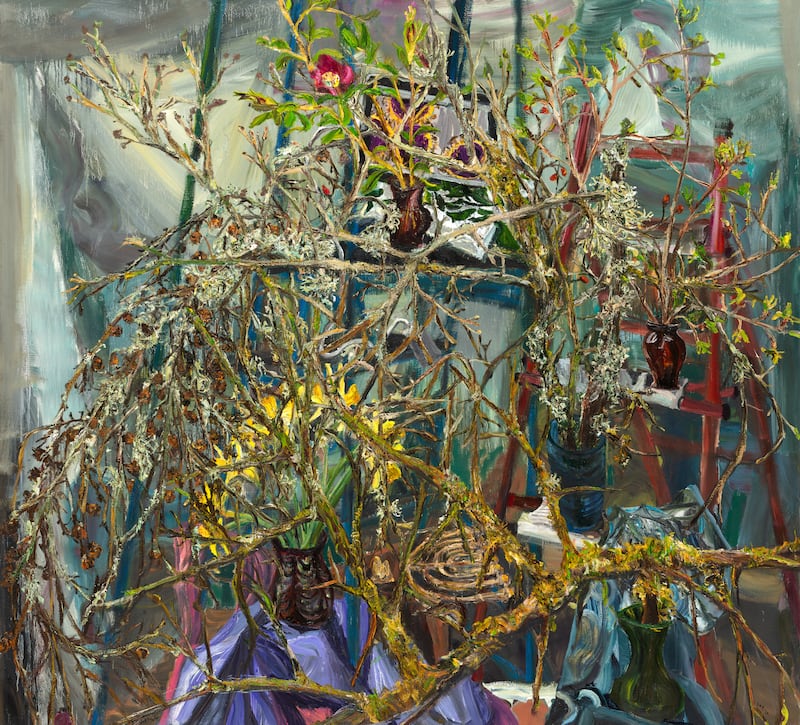
In many ways, art making is a protest against our experience of the inevitable passing of time. The title of Nick Miller’s Branching and Fragmenting Tikkun Olam refers to the Judaic concept of repair and improvement, enacted in practice to maintain the social order. The work itself is a glorious painting in which items, including a menorah lying on its side, and a clutch of vases containing spring flowers and blossoms, are overlaid with a branch reaching into a maze of fragile twigs. In a still life, the flowers never fade or die. Miller’s delicate daffodils will always be at their brightest, while the drier twigs are a reminder of the omnipresence of endings.
Kathy Prendergast’s Ukraine, from 2010, is another reminder of how strong context is in viewing art, and the world. Taken from the artist’s Black Maps series, in which motorist’s maps have been almost entirely blacked out, the tiny spots of white that mark clusters of community in villages, towns and cities are particularly poignant in light of the Russian invasion of 2022.
Like time, mapping, as Brian Friel’s 1980 play Translations so brilliantly shows, is another form of ordering things to exert ownership and control. If time and maps appear inevitable, consider that, until 1880, time in Ireland was measured by the sun at noon, which made perfect sense in an era when farming and a respect for the seasons were the drivers of survival, and when few people had clocks, let alone watches. Time in Cork was different from time in Dublin, and time in Galway different again. It was ultimately standardised to make sense of railway timetables; Greenwich Mean Time was not adopted in Ireland until 1916.
“Do people use maps any more?” Williams wonders, as looking at Prendergast’s map also calls to mind the star-studded sky. GPS, she notes, is controlled by atomic clocks in satellites orbiting Earth. It seems such a fragile network. “If they stopped working, everything would crash,” Williams says, and I wonder how bad some of that would ultimately be.
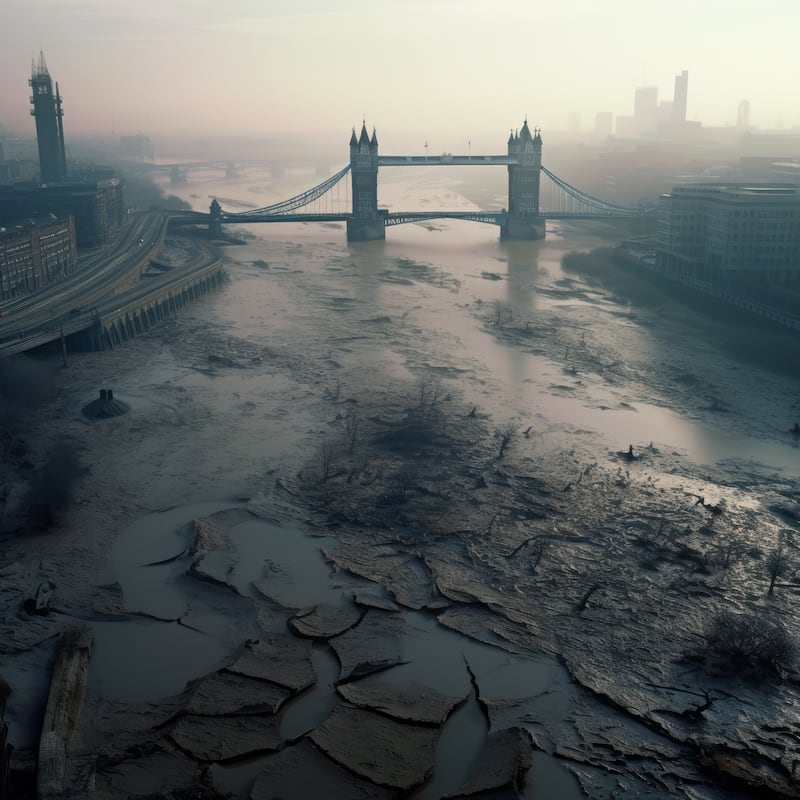
There is something oddly apocalyptic about Phillip Toledano’s AI-generated images from his Another England and Another America series of works. In one, the River Thames is a dried-up mud flat, while in another a figure rides a zebra through the streets of Manhattan. “The impossibility of it lets you read so many things in,” says Williams – some of those things being the chaos and destruction dogging so many of our so-called advances.
When Yinka Shonibare made his Diary of a Victorian Dandy series, in 1998, his large-scale photographs that riffed off William Hogarth’s 18th-century Rake’s Progress etchings also seemed shockingly impossible. A British Nigerian in his baronial hall being attended by white servants? Never. And, of course, it didn’t happen back then, but while Shonibare’s work is still a powerful subversion of the received wisdom bestowed by the falsities of colonialism, subjugation, racism and othering, the imagery may now seem oddly everyday to fans of Shonda Rhimes’ Netflix extravaganza Bridgerton.
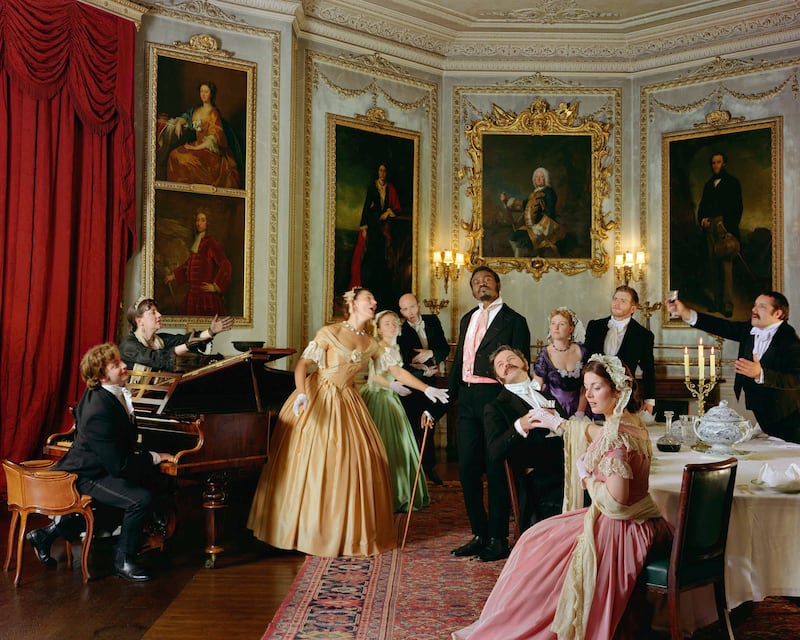
Upstairs, war clouds gather over Rula Halawani’s For My Father series of photographs of her native Palestine. They articulated loss even when they were taken, in 2015. As we struggle to find words that aren’t euphemisms to express the unspeakable atrocities currently being enacted in these landscapes, we come up short. “No matter what words you use, they’re not going to be sufficient,” says Williams. That’s what powerful art is for.
There is a cumulative emotional impact to the exhibition. In the same space, Joy Gerrard’s Dark Europe flags have, according to the artist, morphed in meaning as Brexit segued into Covid, and it is a work the significance of which will only grow as more meanings, and resonances, accumulate over time.
Nearby, a clutch of photographs by Austin Ivers are from his 2020 Threads project, which explored now-obsolete technology from the postwar period. The computers, monitors and keyboards seem quaint and clunky compared with today’s sleek machines, but these were used in cold-war command-and-control systems, when the threat of global nuclear destruction was omnipresently felt. The tech may be obsolete, but the ideas behind it remain.
All are watched over by Ursula Burke’s majestic Caryatid. A female figure from classical architecture, a caryatid holds up a structure in place of a column. Guarded by a pair of Sphinxes, Burke’s is clad in a warming knitted ensemble, including a woolly hat. “Where and how do we find meaning when the structures upon which we anchor our lives, such as family, religion and community, are being eroded?” Burke asked when the work was exhibited at Visual, in Carlow, in 2021.
Williams says that one of the texts that informed her thinking around A Matter of Time was David Rooney’s book About Time: A History of Civilization in Twelve Clocks, which was published in 2021. Through its pages, Rooney describes the way clocks and colonialism can go hand in hand, as both have at their heart power and the dominance of a way of thinking and ordering things. An alternative read is Carlo Rovelli’s The Order of Time, from 2017, in which the physicist explores the subjective nature of time, and how our dominant sense of its linear and absolute nature is relative and flawed.
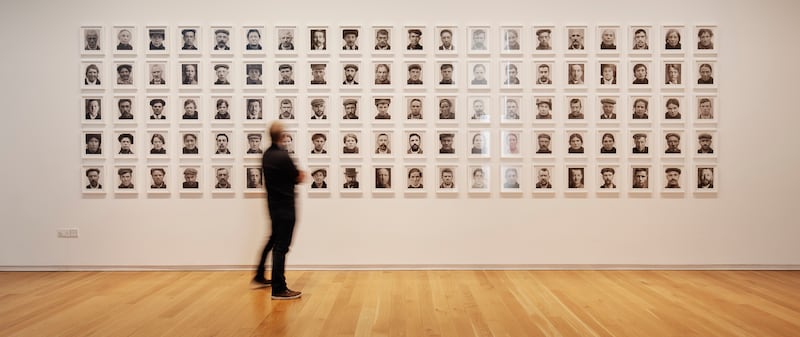
Downstairs, Amanda Dunsmore’s The Peoples’ Portraits 1899-1918 is a series of 100 portraits. Made in 2018, they were selected from thousands of glass-plate negatives that had been mostly taken at Armagh Prison before the partition of Ireland, in 1921. Their anonymity oddly restores their humanity, and there is something strangely contemporary about the faces of these people, as if they had been taken only yesterday.
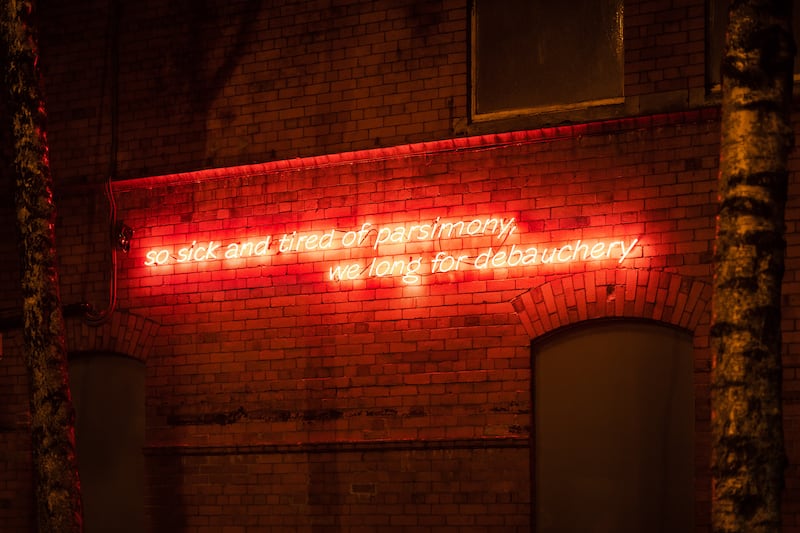
Sara Baume’s neon text that reads “so sick and tired of parsimony, we long for debauchery” illuminated the end wall of the National Sculpture Factory in Cork throughout 2020. I remember experiencing such a phenomenal wave of identification with its message at various points during the pandemic that seeing it today feels like stepping into an emotional time machine. Elaine Byrne’s If We Can Winter This One Out is another work that had its origins in the pandemic but continues to accrue meaning. Added layers now encompass the way that ignoring the climate crisis can make it seem as if we are holding a party at the end of time.
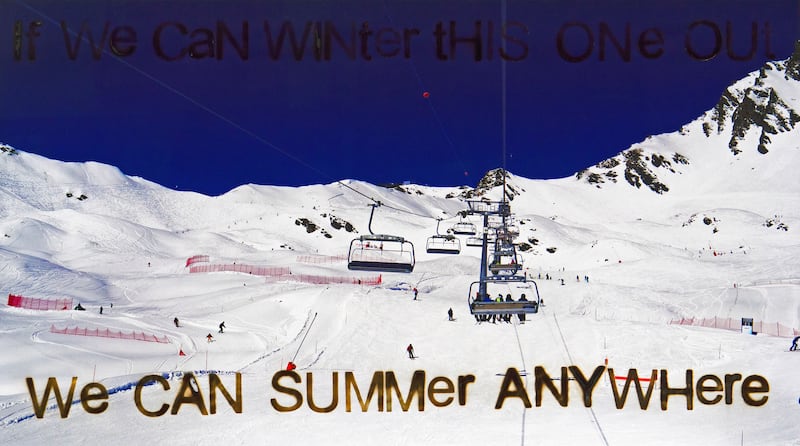
A Matter of Time is set to be the final major exhibition at the Crawford before the galleries close for renovation and development under ambitious plans by Grafton Architects. As such, ghosts of previous shows haunt the spaces: presentations, performances, conversations, ideas and encounters with art leave their marks on the mind. Time carries with it hope and loss – ultimately, mainly loss. We add the hope through what we do with it. As this exhibition shows, a great part of that has to do with art.
Artists on their work in times of conflict and change
Nedko Solakov
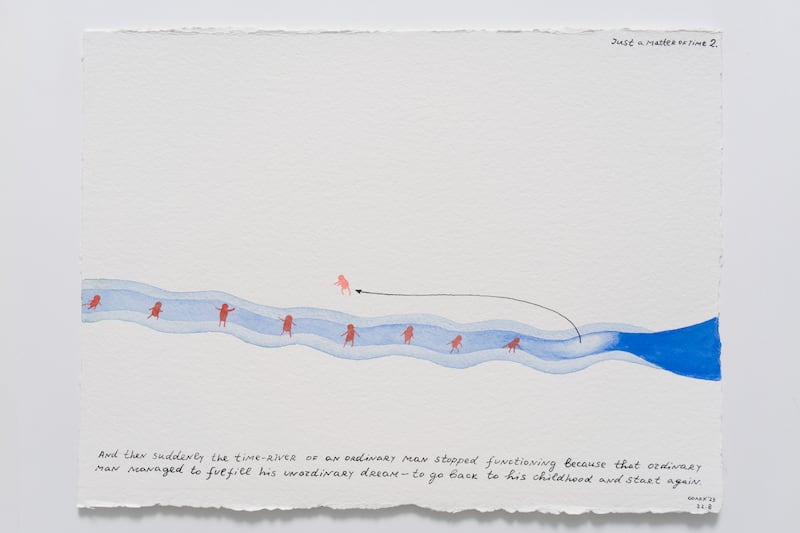
The internationally renowned Bulgarian artist Nedko Solakov, who created his new work Just a Matter of Time for the Crawford exhibition, made his most famous work, Top Secret, in 1989-1990. Documenting the artist’s co-option into collaborating with Bulgarian state security as a young student, it is an extraordinary piece that confronts the corruption of idealism by cynical actors, whoever they may represent. Solakov brought the collaboration to an end in 1983, and later chose to make it public even though, in Bulgaria, state files are still closed. “I wanted it to be a warning to young people who might be misled to fall into the meticulously woven webs of future institutions,” the artist says.
Do artists have a particular role to play in times of conflict? “They just have to be honest artists,” Solakov says. “If they feel their political position as citizens is not enough, then they need to say something strong with their way of doing art. But it is even more dangerous if one follows the political trend and supports this or that fancy political cause with their art than it is to be silent.”
How important is it for artists to make work that addresses the politics of the time? “Bulgaria is the most corrupt country in the EU, and the most corrupt politicians are still in power. Whenever I get pissed by them I do a work – either a drawing or including them in one of my big narrative installations. All this doesn’t change anything, but one still has the feeling that he made his duty. I am trying not to give up hope,” Solakov says. “Sometimes it works, sometimes not.”
Rula Halawani
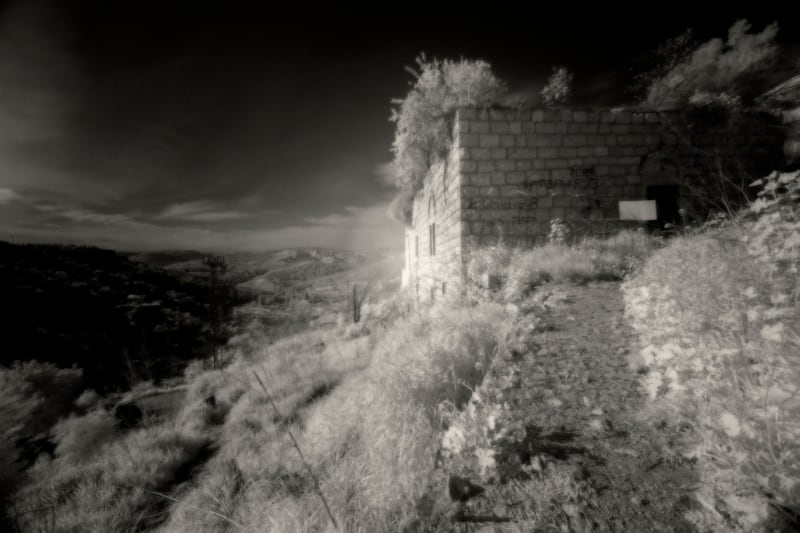
The East Jerusalem-based Palestinian artist Rula Halawani made her series For My Father in 2015. Documenting the transformed landscapes of the artist’s childhood, its 35 images and an accompanying letter – 10 are being exhibited as part of A Matter of Time – memorialised her late father and a land being irrevocably altered, its people’s stories erased by occupation and conflict.
Does art have a specific role to play in times of war? “Works of art can serve as historical relics, documenting the struggles and experiences people went through during times of strife,” says Halawani.
“This documentation is crucial to maintaining the communal memory and making sure that future generations understand the backdrop of the struggle.
“Artists regularly use their works as a platform to speak out against injustice, protect cultural traditions and express their uniqueness. The story of the people and their support for their right to self-determination can be successfully communicated via art.”
So how much can an artwork anchored in a particular time and place have a universal role? “This work transcends its specific location, despite the series’ deep roots in the Palestinian context. These universal themes include human struggle, resilience and the impact of conflict on individuals and communities. Viewers from various backgrounds can interact with and consider the larger ramifications of conflict and the common humanity that unites us all through the photographs.”
Joy Gerrard
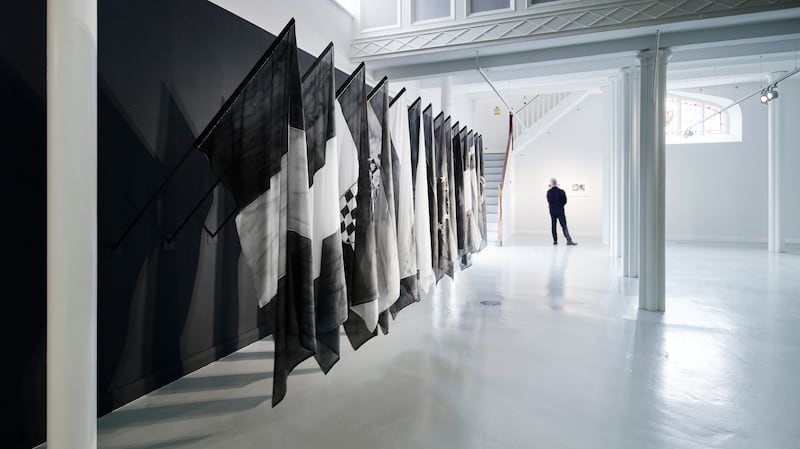
The Tipperary-born, Belfast-based artist Joy Gerrard conceived Dark Europe during the early months of 2020, during a residency at the Irish Cultural Centre in Paris, and made it over the following 12 months. It was initially a response to Brexit (and was originally exhibited alongside Barrier, a painted folding screen showing scenes of protests relating to women’s rights in London); the artist came to also see it as a postpandemic elegy to loss. It consists of all 27 national flags of the European Union, plus the Union Jack, which is hung separately. The silk flags are hand painted in black and white, creating a fragile, unified work.
How much does a work of art that comes from a particular political moment change over time? “Our freedom is more precarious than we realise,” says Gerrard. “I spent a year thinking and rethinking the installation of Dark Europe. It had been a year of tests and transformations, and over that time the work progressed, stuttered, collapsed and regrew.
“Flags are national symbols, but they are often weaponised at times of political change, becoming potent links to nationalism, populism and events of celebration and mourning. Meanings change. The distressing nature of Brexit paled beside the unfolding events of the Covid pandemic.
“As time goes on, more moments, meanings and political movements become carried by the symbolism of a flag. The work carries those changes with it, just as the meaning of national and political symbols changes with how they are used and understood. The hand painting of the flags was important as they became more fragile and present. Painting on silk is difficult to control, so there is a lot of breaking of the internal borders of the flags. I loved making it.”
A Matter of Time is at the Crawford Art Gallery, Cork, until Monday, June 3rd



















